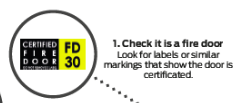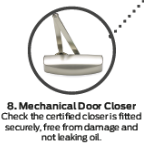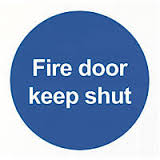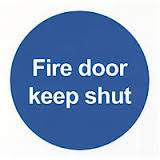Title Page
-
Door Inspected
-
Conducted on
-
Conducted by
-
CE-Marked (Check if there’s a label or plug on the top (or occasionally the side) of the door. It will be CE-marked).
-
Example of CE Mark
-
Fully Closes (Fire doors need to automatically close. Open the door halfway, let it go, and allow it to close. Does it close firmly without sticking on the floor or the frame? Ensure the door leaf sits against the door stop and is free from distortion. If you have double doors, check they close in line if opened and released together).
-
Correct Gaps (The top and sides of the doors should have a gap of less than 4mm from the frame. You can use a pound coin to check, as this is approx 3mm in width. From door to floor, the gap should be less than 10mm when the door is closed. As a rule, if you can see light under the door the gap is probably too big. If the gaps are too large, smoke will be able to get through rendering the fire door useless).
-
Door Frame (Door frames must be firmly attached to the wall and free from damage).
-
Seals (Fire doors must be fitted with intumescent seals. Make sure these are in place, well attached inside the groove in the frame or door leaf, continuous around the frame, and free from damage or paint).
-
Hinges (Each fire door needs a minimum of three hinges, firmly fixed with all screws fitted. The screws should be the correct size and the hinges free from metal fragments and oil leakage. Make sure there are no broken screws).
-
Door Closer (Fire doors must have a door closer to ensure they shut automatically. Make sure this is correctly attached and free from damage).
-
Example of Door Closer
-
Hold open devices (If keeping your fire doors closed all the time is inconvenient, you can fit them with devices to hold them open legally and safely. These must release the doors to close when the fire alarm sounds. If your doors are fitted with hold-open devices, test them weekly to ensure they are in good working order).
-
Damage free (Check that all parts of the fire door are free from damage. Make sure any glass in the door is not cracked).
-
No wedges (Fire doors cannot do their job if they are wedged open. If you spot any fire doors held open in this way, remove the wedge).
-
Latch (Make sure the latch holds the door in place without rattling).
-
Inspection Completed By
















